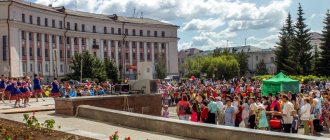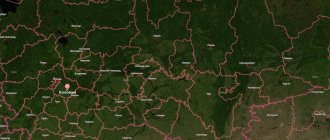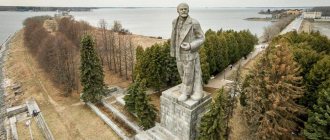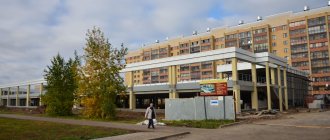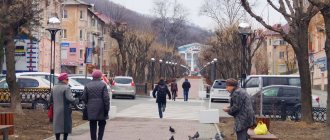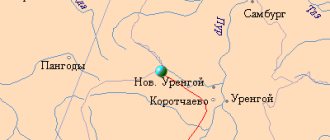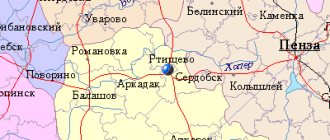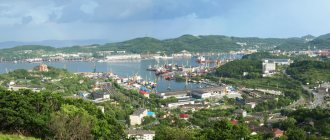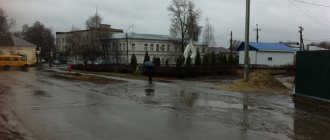Kurchatov on the map of Russia: geography, nature and climate
Kurchatov can be found on a map of Russia 38 kilometers west of Kursk near the Seim River.
The city stretches along the coast of the Kursk Reservoir, the cooler of the nuclear power plant. Part of Kurchatov is located in the water protection area.
The climate is temperate, with high rainfall.
The coldest month is January, the warmest month is July.
The Kursk Reservoir is a habitat for rare species of plants and birds listed in the Red Book.
The city has many green spaces, landscaped parks and recreation areas for the population.
Routes on the map of Kurchatov. Transport infrastructure
P-199 highway connects Kurchatov with Kursk.
The railway line connecting Kursk and Lgov passes through Kurchatov. Long-distance trains to Adler, Kursk, Voronezh, and Liski pass through the railway station.
There are two stations in the city: Kurchatov - for long-distance trains and electric trains; platform 428 kilometer (locally called “Uspenka”) - only for commuter trains.
By bus you can get from Kurchatov to Kursk, Rylsk, Sumy, as well as suburban settlements.
Sights of the city of Kurchatov
A map of Kurchatov with houses will help the traveler to find his way around the city and visit interesting places: on it you can mark the addresses of the locations of attractions.
- Museum of Local Lore . The halls will tell about the nature of the region, archaeological finds, history and people, folk crafts and scientific discoveries.
- Orthodox Church of Seraphim of Sarov and All Kursk Saints.
- Church of the Assumption of the Blessed Virgin Mary, built on the site of an old wooden church destroyed during the years of Soviet power.
- Monument to I.V. Kurchatov , the famous physicist, pioneer of work in atomic science. Located on the central square of the city.
- Monument to the Unknown Soldier , erected in honor of the fallen soldiers-liberators of the village of Uspenka during the Great Patriotic War.
- The sculpture “Peaceful Atom” is a symbol of the use of atomic energy only for peaceful purposes.
- Sports complex "Energetik".
- Monument "Black Tulip" . Dedicated to the soldiers who died in the Afghan war.
Single-industry town statistics: Kurchatov is aging and migrating
Public hearings were held in Kurchatov on the draft decisions of the Kurchatov City Duma “On approval of programs for the comprehensive development of social, communal and transport infrastructures of Kurchatov for 2019-2035.” Three voluminous documents reflect the modern agenda of the city of nuclear scientists, and also contain plans for its modernization and development. According to the authorities, almost 5 billion rubles are required to restore the worn-out infrastructure of the single-industry town.
At the meeting with residents, the speakers briefly and without unnecessary details outlined the essence of the documents. But in order to familiarize yourself with the situation in more detail, we suggest that you turn to the primary sources. The documents that the city administration and deputies worked on during 2021 are available on the official website of the municipality.
DEMOGRAPHY
Having crossed his 50-year mark, Kurchatov noticeably lost his leading position. First of all, as a young and developing city. This is evidenced by statistical data announced by the deputy head of the city, Sergei Rudakov.
Sergey Rudakov, main speaker of public hearings
The migration population loss for 2021 amounted to 423 people. Note that this trend applies not only to last year. Residents have been leaving the city for eleven years in a row. Since 2000, the population of Kurchatov has decreased by 10,700 people.
Dynamics of changes in the population of Kurchatov since 1979
Note that the population decline occurs even against the backdrop of a large-scale construction campaign at the federal level. Despite statements by the authorities that the construction of Kursk NPP-2 will attract thousands of new workers to the city, so far there has only been an outflow of labor resources.
The average resident of the city of nuclear scientists has also noticeably aged. Today he is 40.33 years old. Only 55.4% of the population is of working age. The mortality and birth rate statistics are quite indicative. If before 2021 demographic data had positive dynamics, then in the last two years the number of deaths has begun to exceed the number of newborns.
The demographic situation of the city of power engineers is most clearly shown by the birth and death rates. Against the backdrop of global indicators, a noticeable lag in Russian demographic policy becomes obvious.
Local officials see the reasons for the unstable demographic situation, of course, in the corrupting work of the media:
“The formation of new stereotypes of lifestyle and consumer standards by the media leads to a decrease in the quality of family education, aggravation of conflict between generations, and the severing of family ties. All these reasons led to a sharp decline in the birth rate and a decrease in the number of families wishing to raise three or more children.”
There is some good news in the official report. Thus, for the first time in modern history, Kurchatov will not be closed, but preschool institutions will be built True, these are not full-fledged kindergartens, but only extensions to existing institutions. To fill four nursery groups for 40 people, aged from two months to three years, it is planned to build extensions to kindergartens No. 2 and No. 12. These expenses have already been included in the federal funding program.
PHYSICAL EDUCATION AND SPORTS
The report is replete with numbers and optimistic conclusions, which are not always correct. For example, they write about the pool: “In the Energetik sports complex there is a swimming pool with Olympic-standard lanes. Regional and all-Russian competitions are held here.” The last statement is not true, since in order to hold official competitions, the sports complex must be included in the register of sports facilities of the Russian Federation.
Excerpt from the program with false information
The owner of Energetika, the Rosenergoatom concern represented by the Kursk NPP, is not yet going to do this, citing the impossibility of financing a non-core institution. Let's say more. In all of Kurchatov there is not a single sports facility included in the register. However, in the program for the comprehensive development of social infrastructure, there is no information about plans to change the sad statistics.
RETAIL AND BUSINESS
One of thirty-three Kurchatov supermarkets.
In 2021, there were 693 individual entrepreneurs and 214 small businesses in Kurchatov. The consumer market consists of 387 objects. The largest share in the turnover of large and medium-sized enterprises is made up of supermarkets. In the city of 40 thousand 33 stores of large retail chains: Thunder ( 10 Magnit stores), Red and White stores Europe stores 5 Pyaterochka stores), Best Prize ( 2 Fix Prize stores ), Armada shopping center, Grinn Corporation JSC, Euroset stores 1 Svyaznoy store. The next one is currently being prepared for opening.
HEAT SUPPLY, ELECTRICITY SUPPLY, WATER SUPPLY, WATER DISPOSAL
The most painful areas for 50-year-old Kurchatov are the outdated utility infrastructure. of heating networks alone is 60.84 km. 68% of pipes need replacement. The total amount of funds needed to modernize the heat supply system is 2.648 billion rubles.
The water supply system is built on the use of Kurchatovsky and Dichnyansky water intakes. Moreover, the license to use Kurchatovsky expires in September 2021. Here, too, the main problem is the moral and physical wear and tear of fixed assets. During 2014-2017, not a single well was drilled and no new water supply networks were built. Repair of networks per year was no more than 1.5 km. Existing water supply networks are operating at the limit of resource reliability. 83% of water pipelines are completely worn out and require replacement. In the municipality, the networks are worn out at 78%.
Another problem is outdated technological schemes for water purification. As a result, the content of some chemical elements in water intake in certain periods exceeds the norm by up to two times. Due to the dilapidation of water pipelines, water readings for iron deteriorate.
The plans include replacing steel pipes with non-metallic ones, reconstructing water intakes and many other measures worth 1.136 billion rubles.
The sewerage system covers 160 residential buildings and 290 other consumers. Wastewater disposal in 2021 - 2.8 million cubic meters. The actual wear rate of sewer networks is 80%. 328 million rubles are needed for its reconstruction and modernization. In addition, the power lines supplying the treatment facilities are in disrepair. In 2021, residents of old neighborhoods living on the upper floors have already felt the “effect” of emergency situations.
The storm sewer system in Kurchatov does not meet modern requirements. All runoff from roads today is discharged into open water in an untreated form. The city planning project provides for the construction of treatment facilities for surface wastewater. However, no money has been planned for this work yet.
In the field of municipal solid waste management, the main problem is the deterioration of the fleet of garbage containers, which today are managed by management companies, and the lack of equipped container sites.
power grid includes 71 substations, 226 km of power lines, 77 km of street lighting lines. The level of physical wear and tear of networks is 40-50%. Depreciation of transformer substations -70%. To restore the electrical system of the city, power engineers require 810 million rubles.
In the program for the comprehensive development of the transport sector, the main direction is to increase the level of road safety and the accessibility of transport services for the population. The program includes the construction of an overpass across the railway, a bus station with a pedestrian bridge across the railway tracks, the installation of six more traffic lights on the Kursk-Rylsk highway, repairs of public roads of the road fund and the street road network. In addition to these objects, the document also identifies a number of others, the construction of which is expected to be carried out in the period 2013-2022:
1) Expansion of the Dichnyansky water intake with the construction of a water pipeline in the Kurchatovsky district of the Kursk region;
2) Construction of a storm sewer system with treatment facilities;
3) The third line of the pressure sewer sewer from KNS-5 to the gravity flow of the city of Kurchatov;
4) Construction of a road network with sidewalks in new neighborhoods of the city;
5) Construction of an ice palace with engineering infrastructure;
6) Construction of a highway in the 7th and 10th microdistricts of the city of Kurchatov;
7) Construction of a garage complex in the 7th microdistrict of Kurchatov;
 Construction of preschool institutions in the 7th microdistrict of Kurchatov;
Construction of preschool institutions in the 7th microdistrict of Kurchatov;
9) Construction of trade and entertainment facilities in the 7th microdistrict of Kurchatov;
10) Construction of a hotel in the 7th microdistrict of Kurchatov;
11) Construction of a gas boiler house in the 7th microdistrict of Kurchatov;
12) Construction of treatment facilities in the 7th microdistrict of Kurchatov;
13) Construction of an electrical substation in the 7th microdistrict of Kurchatov.
“The numbers you heard here are big, but in fact there is no provision for them yet,” the chairman of the City Duma, Alexey Suzdalev, . That is, we can talk about financing in 2021, and not about the distant future - until 2035.”
The hearing participants recommended that the head of the city of Kurchatov send the draft updated comprehensive investment plan for the modernization of the single-industry town for approval to the City Duma.
PS. On November 29, deputies will begin considering Kurchatov’s budget for 2021. utility bills, taxes and salaries will be 100% financed . The rest: 30-31% of needs. According to rough estimates, the shortage of funds will amount to 160 million rubles.
Main streets of Kurchatov
On the detailed map of Kurchatov you can see not only large highways, but also small streets.
- Garden Street . It is part of the P-199 highway. The main street dividing the city into two parts. Length -2.5 kilometers. It starts from Mira Street, stretches past microdistricts 5 and 6, intersecting with Energetikov Street. There are many green spaces along Sadovaya. It ends at the intersection with Embankment Street, nearby is the old city cemetery and the Church of John the Baptist.
- Street of Cosmonauts . Length – 1 kilometer. It originates from Molodezhnaya Street. It goes around microdistrict 2 from the Kursk Reservoir. Intersects with Pionerskaya. It ends at the intersection with Gaidar Street.
- Energetikov Street. Length – 1.7 kilometers. It starts from the intersection with Stroiteley Street and goes around the 4th microdistrict. It runs past the park area in which the temple in honor of St. Seraphim of Sarov is located. Separates microdistricts 5 and 6, then goes out onto Sadovaya not far from the city hospital complex. At the intersection with Naberezhnaya Street there is the Emerald City Park.
- Embankment street . Length – 1.2 kilometers. It starts from the intersection with Energetikov Street, goes around the 6th microdistrict and goes out onto Sadovaya Street.
- Communist Avenue. Length – 950 meters. It starts at Nikolaev Square, at the intersection with Molodezhnaya Street. It closes 1 microdistrict from the north, passes by the district administration, ends in the area of Freedom Square at the intersection with Sovetskaya Street near the Palace of Culture and the Energetik sports complex.
- Molodezhnaya Street. Length – 570 meters. It goes around the 1st microdistrict from Nikolaev Square, intersects with Kommunistichesky Prospekt, and in the 2nd microdistrict it turns into Cosmonauts Street. On Molodezhnaya Street there is the Kurchatov Museum of Local Lore.
Location: Kurchatov, Kazakhstan
I didn’t understand what role the comment under the “vk” logo plays on your site and whether anyone else besides me sees it, so I’ll duplicate it here as well.
Dear Natalya, I read your thoughts about the new science city on the territory of Kazakhstan. My ideas about this city and its future are somewhat different from yours. Don't take this as a reason to ignore my comment on your article.
Let me start with the fact that my father and my mother celebrated Victory Day 1945 in Koenigsberg after its assault by our troops. My father was an officer at the front, a specialist in the construction of various types of water crossings. This is actually a very dangerous military profession - imagine building, for example, a pontoon bridge under continuous artillery fire and bombing from aircraft, because... the enemy always tries to prevent the construction of such structures. It was no coincidence that he was wounded twice by shrapnel: one wound in the leg, the other in the head (thank God, the shrapnel went tangentially). Then he was in Poland for some time, guarding prisoners from the army of German Field Marshal Rommel, who were digging potatoes, which were then sent to the hungry Soviet Union. Why am I telling you this? This sheds light on what kind of people built the landfill you are writing about, as well as the role of the Kazakh SSR in the construction and operation of the landfill. Suddenly, quite unexpectedly, in the fall of 1947, he was ordered to appear at the appointed office of the General Staff on Arbat. Here he is sent to one of the cities of the Volga region, where a train with military personnel is already being formed. The echelon moved east - no one knows where. At each subsequent stop, the name of the next destination is given. Thus, they reached Pavlodar, then loaded onto barges and sailed upstream. Nobody knew where the unloading would take place. Where there is a well-known rock on the shore, an officer was waiting for them with instructions to disembark at this very place. My father was the first commandant of this military settlement. Cold winter was coming. It was necessary to somehow settle down. There were no building materials. They dug holes with steps and covered them with willow, which was then abundant on the banks of the Irtysh. This simply means that the creation of the test site was an emergency. My father was at the front from the first day of the war. He didn’t talk much about life at the test site during its creation, but sometimes I heard from him that it was not as difficult as it was in the first years of the test site’s operation, even at the front.
My mother and I came later, first to Zhana-Semey (I was two years old at the time), and then in 1954 to the town, where we got a two-room apartment with neighbors in an eight-apartment building on Oktyabrskaya Street. I was already in second grade. I don’t know what the town was called then, but not Kurchatov, not Semipalatinsk-21 and not Konechnaya. The address consisted only of the number of the military unit - military unit 52605 or, for example, military unit 14169, in short, the unit where my father served. It’s worth talking about high school separately. At first its number was No. 1 without reference to the republic, and then No. 20 MP of the RSFSR. I would like to talk about our teachers separately. Almost all of them were wives of officers who were sent to serve at the training ground. Officers, many of whom were young front-line soldiers, after graduating from military academies in Moscow (these were the ones who were sent to the training ground) married young girls, including those who studied at Moscow pedagogical universities. It is not difficult to understand that the time they studied at the institutes was during the war years. I already understand that our teachers were amazing people. It is impossible to find enthusiastic epithets addressed to them; all of them (epithets) seem somehow petty and meaningless. Suffice it to say that in the first three graduating classes of the school there are five or six academicians and corresponding members of the Russian Academy of Sciences. Even the physics teacher became a corresponding member of the Academy of Sciences. True, some of them are no longer alive.
Now about the most important thing, which is why I started this comment. What role did the Kazakh SSR play in the creation and operation of the test site? No. There was only interaction and coordination of actions at the level of equal partners. The test site was managed from Moscow. How did Soviet power suddenly appear on the training ground in the person of the Communist Party and the City Executive Committee of Kazakhstan, seemingly led from the regional center of Semipalatinsk. Everything is very simple. In the early seventies, a new commander, Lieutenant General A.A. Smirnov, arrived at the training ground, a worthless and immoral person in many respects. Under his leadership, the clean town very quickly turned into a polluted area, a garbage dump. In order to relieve himself of responsibility for this area of his work, on his initiative, party and city bodies of the Kazakh SSR were created. Now the state of the city could be attributed to them. But in fact, nothing changed, because the new government did not have departments that would be subordinate to them: thermal power plants were maintained by the military, repair work and accidents were also carried out by the military, the bakery was military, etc. The leadership of the new government had only a table, a chair, a pen, a telephone and a personal car, and it did not influence anything.
There were always many civilians at the training ground. These are mainly builders, miners, drillers. In general, at the test site, in addition to the facilities intended for testing nuclear weapons, where workers of the above-mentioned professions mainly worked, there were several facilities intended for nuclear research. At the “Sh” site, on the initiative of Kurchatov, a pulsed reactor RVD (explosive reactor) was built in the late 50s. It was designed at the Institute of Atomic Energy, which now bears the name of Kurchatov, and was made at the test site to study the operation of the reactor under extreme conditions, which was associated with the possibility of its explosion. But, as it turned out, the reactor was designed so well that even in unusual situations it did not want to explode. The reactor had a unique property: the reactor's pulse power was maximum compared to the powers of other reactors. This made it possible to use the reactor for researching various materials under conditions of exposure to gamma quanta and neutrons of maximum density. In addition, at site “10” there was an IVG-1 reactor, intended for research of fuel rods and fuel assemblies (fuel assemblies) under conditions of their cooling with gas (hydrogen). The reactor itself was designed at the IAE named after. Kurchatov, and unique fuel rods were developed and created at PNITI (Podolsk Scientific Research Technological Institute). I took part in testing the gas-dynamic part of this device (installation “300”) in the Moscow region at the NIIKhimMash enterprise. In addition, at site “10” there were two prototype nuclear engines with their own reactors 11B91 and 11B92. The first was intended to adjust the trajectory of an object launched into space, and the second was supposed to be used as a rocket propulsion engine. The reactor parts of the engines were developed at the IAE named after. Kurchatov, and the gas and thermodynamic part at the Research Institute of TP (thermal processes, this is now the Keldysh Research Center, which is located in Moscow, metro station “Vodny Stadion”). Tests of these nuclear engines have been carried out at the test site since at least 1976 (on March 8, 1976, the “300” installation with the IVG-1 reactor was tested for the first time). The question is, where is the role of Kazakhstan, its scientists, its institutions in these developments? Nowhere!
However, in the summer of 1991, when by decree of the President of Kazakhstan Nazarbayev the landfill was closed, by the same decree all objects located at the landfill became the property of Kazakhstan. So, leading Russian scientists developed and built these unique objects, and the President of Kazakhstan, by his decree, immediately took and simply appropriated them for himself. Later, in 1993, Russia negotiated with Kazakhstan about the possibility of returning some of the objects to the ownership of Russian organizations. These negotiations ended without result. Natasha, you are an honest person, it seems to me, tell me: “What is this called?” Yes, we have lost these devices, but this loss can be corrected - we will build new ones, better than the previous ones. The main thing is not in the devices, but in the people who created them, the main thing is scientific and industrial schools, and we still have them. You haven’t acquired anything essentially except an appropriate attitude towards yourself. The main thing, if you haven’t already understood, is scientific schools. It is impossible to create on the basis that fell to you as if from the sky, in the conditions of a scientific school training ground. This requires time to go the same way that Russian scientists did, and resources measured by the scale of the state (schooling, education and training of your students in your institutes, and not in Tomsk, in the end, you need the appropriate mentality of your people) .
But raiding (seizing someone else’s property) of Russian developments is just the beginning, and now I’ll tell you about the berries. The site contained a treasure on a universal scale - a secret library of secret owls. secret and especially important documents describing all experiments conducted at the test site since its creation. There was such a rule: the first copies of all documents with experimental and scientific data that appeared at the test site were sure to go to this library. After the Belovezhskaya agreements on the division of the Soviet Union into parts, literally the next day, people in white sheepskin coats of Kazakh nationality, armed with short machine guns, appeared at the training ground, apparently from the state security units of Kazakhstan. These people took protection of all important objects at the training ground, including this secret library. In my opinion, the news of the loss of the library in Moscow made the government's hair stand on end - no one expected such treachery. Just imagine, secret data about nuclear tests falls into the wrong hands. An order came from Moscow to remove the library by any means. At night, the range security battalion disarmed the young men in white sheepskin coats guarding the secret library. Then they loaded the secret documents onto KAMAZ trucks, transported them to the local airfield and sent them to Moscow by AN-26 military transport aircraft. All this happened in an emergency under the cover of darkness. Soon, the head of the test site, who was after A.D. Ilyenko, was declared an enemy of the Kazakh people and put on the wanted list by the Kazakh government. But, thank God, he managed to leave Kazakhstan. What are you doing? I don’t understand how anyone can have any business with you after this.
Well, I treat you very well. After my father’s demobilization, my parents lived in Ust-Kamenogorsk, and I often came there. The warmest memories of this city. Best regards, Valery.
PS: The control panel for nuclear explosions was located in the museum of the scientific research station of military unit 52605. After the disbandment of military unit 52605, this exhibit should be transferred to the 12th Main Directorate of the General Staff of Russia, under whose subordination this military unit was located. A museum exhibit is not a test site, but the museum property of a military unit. I saw this exhibit in your picture and felt a bit uneasy. It turns out that you stole everything, including a story that is not yours.
